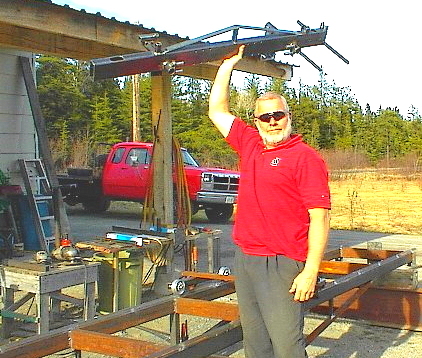

What is the difference between 'I' and 'C' frame powerheads? Just as the letters appear, an 'I' frame is a straight "bar" with the bandwheels at either end. A 'C' frame is like the large traditional shop band saws with the bandwheels at the ends of the 'C', to give a larger "throat" and a greater cutting depth. This is important for shop use but because a 'C' frame is weaker by design it must be made much heavier to compensate, but this is not a problem for a machine that just sits on the floor. Not being engineers, sawmill builders took this shop bandsaw design (that they knew) and turned it on its side. This is unnecessary in a sawmill. You don't need this "deep throat" to cut boards from the top down. Their mills could actually cut the bottom of the log in the first cut which would be ridiculous, of course. This unnecessary "ability" comes at a cost, so the powerhead must be made bigger and heavier, therefore more cumbersome and expensive.
typical deep throat 'C' frame powerhead of the past and still even being used today
What is the optimum blade speed? The best blade speed, measured in feet per minute or fpm depends on a number of factors including the type and thickness of the wood, whether it's frozen, motor horsepower, etc... More speed requires more power but too much speed can cause excessive friction and bandwheel vibration. Too little speed takes too long to cut through the log and you could be wasting power. With a 13 hp motor, 19" bandwheels and a 4 1/2" motor pulley at 3600 rpm the blade speed will be 4265 fpm, a good compromise.
Since Mr. Sawmill is so efficient (the motor directly drives the bandwheel) I use a 4 3/4" pulley (i.e. centrifugal clutch) for a blade speed of 4,500 fpm with excellent results.
Do I Need A Centrifugal Clutch? The industrial centrifugal clutch that I use costs $300 and a simple pulley costs about $20. If you want the blade to be stopped when the motor is idling then you must either use a centrifugal clutch or design a motor engagement system where the motor (or an idler pulley) moves to loosen and tighten the drive belt.
This puts a little more wear on the drive belt as it slips during engagement and there is an extra mechanism. It is possible to use just a fixed motor and pulley (the simplest design) but the blade will be moving all the time. Some may consider this more dangerous, turning and clamping a log beside a running blade but it's not as bad as it sounds. The blade is moving slowly, only a small part is exposed (with proper guards) and you're turning logs from the centre and clamping away from the ends. You can load shorter logs, with the end more than six feet from the blade. It's still far safer than any chain saw.
You could try that out and see how safe you feel with it, knowing that it's a simple job to change to a centrifugal clutch later. Since most motors are so easy to start (one pull) you could just turn them off. You'll be starting the motor with the blade engaged but it's not that difficult. You will put more wear on your pull start mechanism though.
"New knowledge lets you think you know more than you do, because you now know more than you did." D. J. Huggett
"If enough do wrong for long, it becomes right." D. J. Huggett
When I designed my first 'I' frame in the Model One, all the major sawmill manufacturers were using the cumbersome 'C' frame design, so heavy that it would be impossible for anyone to do what I'm doing in the right photo. Since my first website showed the Model One in the 1990's, some manufacturers have started using the 'I' frame design in their mills too and it's becoming more popular.
"Imitation is the sincerest form of flattery" Charles Caleb Colton
What about purchasing blades? Many sawmill manufacturers supply blades for their mills and you buy from them. With a homebuilt mill, just Google "sawmill bandsaw blades" to find the name of a blade supplier near you, (or one that ships nationwide) so that you can buy direct. Most suppliers will ship the blades to your door in a few days. A popular blade for small mills is the Lenox Woodmaster "C", 1 1/4" wide X .035" thick and a 1.1 set.

"Things should not be multiplied beyond necessity." Occam's Razor
"I always use 'First Principles' in my designs." D. J. Huggett
(see page bottom)
First Principles Analysis
"Let's boil something down to the most fundamental principles, the things that we are most confident are true at a foundational level. That sets your axiomatic base and then you reason up from there. Then you crosscheck your conclusion against the axiomatic truths. If you violate the basic laws of physics (like the conservation of energy or momentum, etc.) then it's just not going to work.
Think about things in the limit. If you take a particular thing and scale it to a very large number or a very small number, how do things change?
Manufacturing is a very underrated problem. It's much harder to take an advanced technology product to volume manufacturing than it is to design it in the first place - by orders of magnitude."
Elon Musk (talking with Lex Fridman - podcast #252 - Dec 29/2021)
my Model Two's 'I' frame powerhead
"Most of the luxuries and many of the so-called comforts of life are not only not indispensable, but positive hindrances to the elevation of mankind."
Henry David Thoreau 1854




























